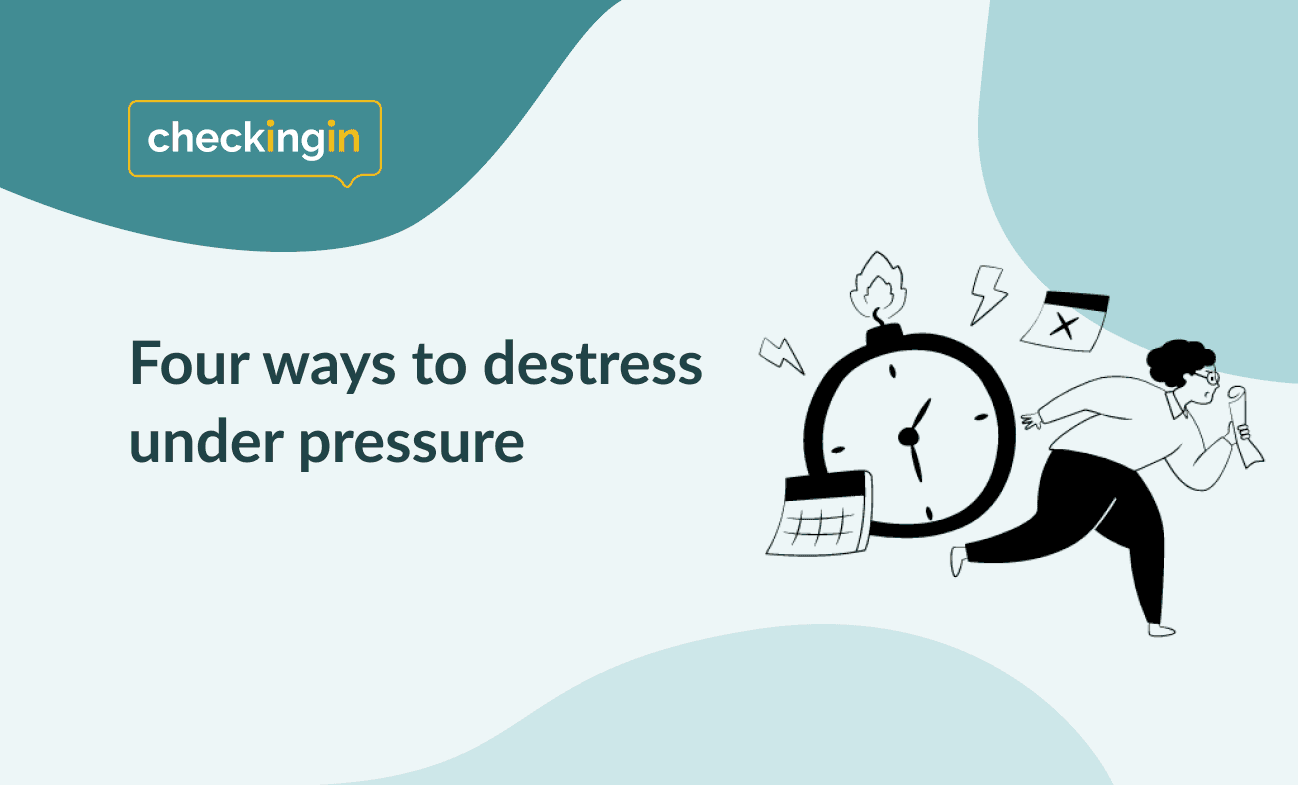Four Ways to Destress Under Pressure
March 11, 2022by Emma McILwane in Tips & Tools
Working under pressure can cause additional unnecessary stress. Try these useful techniques when you feel an overwhelming sense of stress and anxiety.
Stress, when not controlled, can be an extremely overwhelming and negative emotion. While not all stress is harmful, most perceive it to be so. To de-stress, we first need to become aware of it - recognize the stressor and how it makes you feel. Depending on the type of stress you are experiencing, the ways to destress will vary, especially when you’re under pressure!
4 Ways to Destress Under Pressure
Breathing Techniques
Alternate Nostril Breathing: This breathing technique can relax your mind and body and create a grounding effect by reducing anxiety and improving overall well-being. By becoming more aware of our breath, we can also refine awareness in other parts of our life.
The practice is simple - place your index finger over the side of one nostril, apply pressure to close it off, and inhale, counting to 5. Swap your finger over to block the other nostril and breathe out, counting to 5. Repeat these steps until you feel calm and grounded.
Fire Breathing: This fiery practice will get your body warmed, your oxygen levels to increase and cleanse your lungs, and increase your overall energy. With prolonged practice, fire breathing, also known as Kapalbhati breathing, has been shown to improve digestion and strengthen your abdominal muscles.
Start with a short, explosive exhale and a passive inhale to reawaken your senses and then tackle your most important tasks for the day!
Box Breathing: If you feel the need to be calmed and recentered, box breathing is a perfect way to accomplish just that. This practice can help reduce stress and instantly improve your mood. Repetitive deep breathing has been shown to regulate the autonomic nervous system, regulating body temperature and lower blood pressure!
To begin, inhale deeply, filling all corners of your abdomen with air and hold. Slowly breathe out, feeling your chest cavity empty completely. Repeat this practice until you feel grounded and collected.
When used in the later hours of the day, box breathing, also known as square breathing, can help you to enjoy a more restful and restorative sleep.
Vibrations Breathing: On the days where your mind can’t seem to shut off and a constant flurry of thoughts are swirling around in your brain, try vibration breathing. This practice activates the parasympathetic nervous system, which controls rest and digestion, and deactivates the sympathetic nervous system’s fight or flight response.
The name vibration breathing stems from a black Indian bee, the Bhramari, which sounds similar to that of a bee when exhaling in this exercise. This vibrational hums effectively support the nervous system and can help you to cope with intrusive thoughts.
Choosing Stillness
One key to de-stressing is knowing when to take a step back. Recognize the stressor that is causing pressure and anxious feelings and physically step away from it for a few minutes. Find an open space on the floor and sit down in a comfortable position. During this time, find a moment of stillness; silence, peace, and calm. Stillness can increase our sense of grounding, significantly decrease anxiety, and improve productivity.
While practicing stillness, recognize your feelings and emotions as valid. Accept your thought, and let it pass - do not focus on more than one thought at a time. Simply think it, accept it and let it go. Eventually, your brain will be calm and productive, helping you unwind and destress.
Positive Reappraisal
Working under pressure can generate a lot of negative emotions and thoughts. To combat this, find alternative ways to interpret a situation. Positive reappraisal can help to retrain your brain from automatically assessing a situation as negative or involuntary negative thoughts.
Every moment of every day, your brain is receiving information. It’s only natural that we treat new thoughts as purely truthful before the information is made sense of. This can be particularly damaging when the majority of our thoughts are negative. Therefore, it is important to utilize positive reappraisal to take a moment, recognize the thought, then evaluate it. This will increase resilience and help to gain control of our intrusive thoughts.
A simple step is to reframe a negative thought as valuable or advantageous. For example, if you’re constantly thinking you're unfit for your job or do not possess the best skills for a task you were assigned, redesign this thought. Tell yourself you earned your spot in your role and you were assigned this task because of your creativity, drive or whichever trait best suits the situation, makes you the most suitable candidate.
Guided Meditation
Sit back, relax and listen to the calming voice of guided meditation guide you through a mental journey of tranquillity and relaxation. Guided meditation, when fully immersed, is a very powerful tool.
This practice reduces intense anxiety and stress by using visualization techniques to ease the mind and decrease muscle tension. The beneficial aspect of this practice is there is no limit on the duration. If you are feeling particularly stressed, you can make your practice a few minutes or even several hours.
As a beginner, it’s important to start small and go slowly. Mental visualization and physical stillness can be quite challenging for people, so try not to get frustrated in the beginning. Find a comfortable seat, plug in some headphones and allow your mind to be guided into a state of relaxation.
Stress manifests itself in various ways for all individuals. There is no one right way to destress. It’s also likely to take a few practices to find what works best for you! The key here is to not let frustration take over. Find peace in the fact that you are trying to become your best self with a strong mental state, and know you will find your best practice in time.

